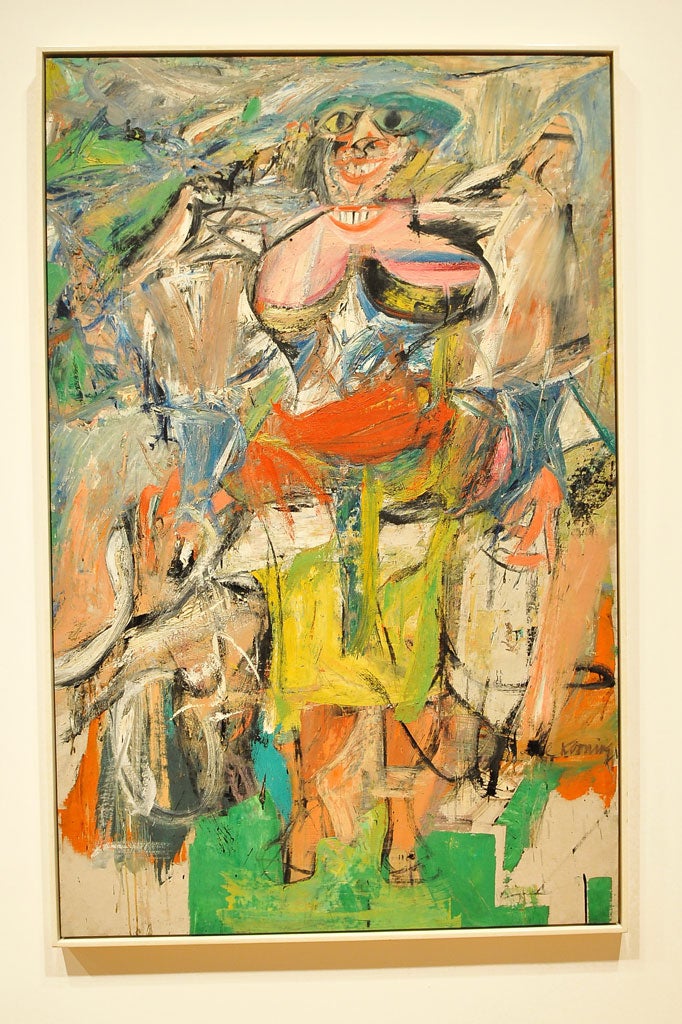Great Works: Woman with Bicycle, 1952-3 (194.3cm x 124.5cm), Willem de Kooning
Whitney Museum of American Art, New York

By the 20th century, the human body was being disassembled and re-assembled by painters of the various avant garde schools to an almost wild and frightening degree. You can almost hear the uproar as they did all that metaphorical sawing and hacking. This was the century of the uncalm, the feverishly experimental, the moment when the terrible undercurrents rose up and overwhelmed the surface.
Is this what Freud, Nietzsche and two huge, murderous bouts of warfare – to name but three tentative explanations for all this wilful painterly disorder, this arrant refusal to accept the testimony of the human eye – had brought us to? Whatever the explanation, the human form began to resemble tomorrow's new model as it is tinkered and messed with on its slow passage through the Nissan factory. That is not an entirely satisfactory analogy – there is no sleek and clean-lined conclusion to this painting.
Instead, we feel that the body itself, this staring-eyed female form, is no longer quite singular and whole. It is not undeniably self-contained. It is not even of and for itself. It has loosened the grip of reasonable self-control – and so has its making. It's a joyous, messy patchwork of hectic gesturings. There is no easy contemplation of the surface, no celebration of the essential symmetry of the human form. What Leonardo created in his great drawing of Vitruvian Man, those long centuries of thought which had led to the conclusion that man was somehow aligned with the divine order of things – or, at the very least, divine orderliness – no longer seems to appertain. There is no longer any way in which de Kooning's woman is underpinned by any notion of harmony or universality. She is out on her own, staring at us, bulbous-eyed, in all her colourful raucousness, utterly unruly, bursting apart at every seam. And she is alive within a general context of painterly unruliness – the brushstrokes of this painting power off in so many different directions.
In fact, she looks like a precarious agglomeration of parts. If this were music, it would be a simultaneously cacophonous rendition of Schönberg and Webern. It seems shrill and hyper-active, almost at war with itself – a jagged, terrible, extreme example of grotesquerie. Did Picasso light the touch paper? In 1909, he certainly committed unspeakable acts of violence to the depiction of the female form in Demoiselles D'Avignon. Forty years on, de Kooning, painting in New York, seems wilder still. This painting is one of a series of many ferocious attempts to render the female form. We feel this painting had no easy beginning and no easy end – more exhausted abandonment than anything you could call an end.
ABOUT THE ARTIST
The Dutch-American painter Willem de Kooning (1904-1997) was born in Rotterdam and moved to New York in 1926, where he worked first as a painter and decorator. One of his powerful early influences was Arshile Gorky, who practised a kind of wayward Surrealism. De Kooning became an important member of the New York group of Abstract Expressionists. His paintings of women during the 1950s – they were said at the time to be evidence of "the new figuration" in New York painting – caused a tremendous stir in the art world, such was their energy and violence. He continued to work in his gestural manner until the failure of his health in 1990.
Subscribe to Independent Premium to bookmark this article
Want to bookmark your favourite articles and stories to read or reference later? Start your Independent Premium subscription today.

Join our commenting forum
Join thought-provoking conversations, follow other Independent readers and see their replies